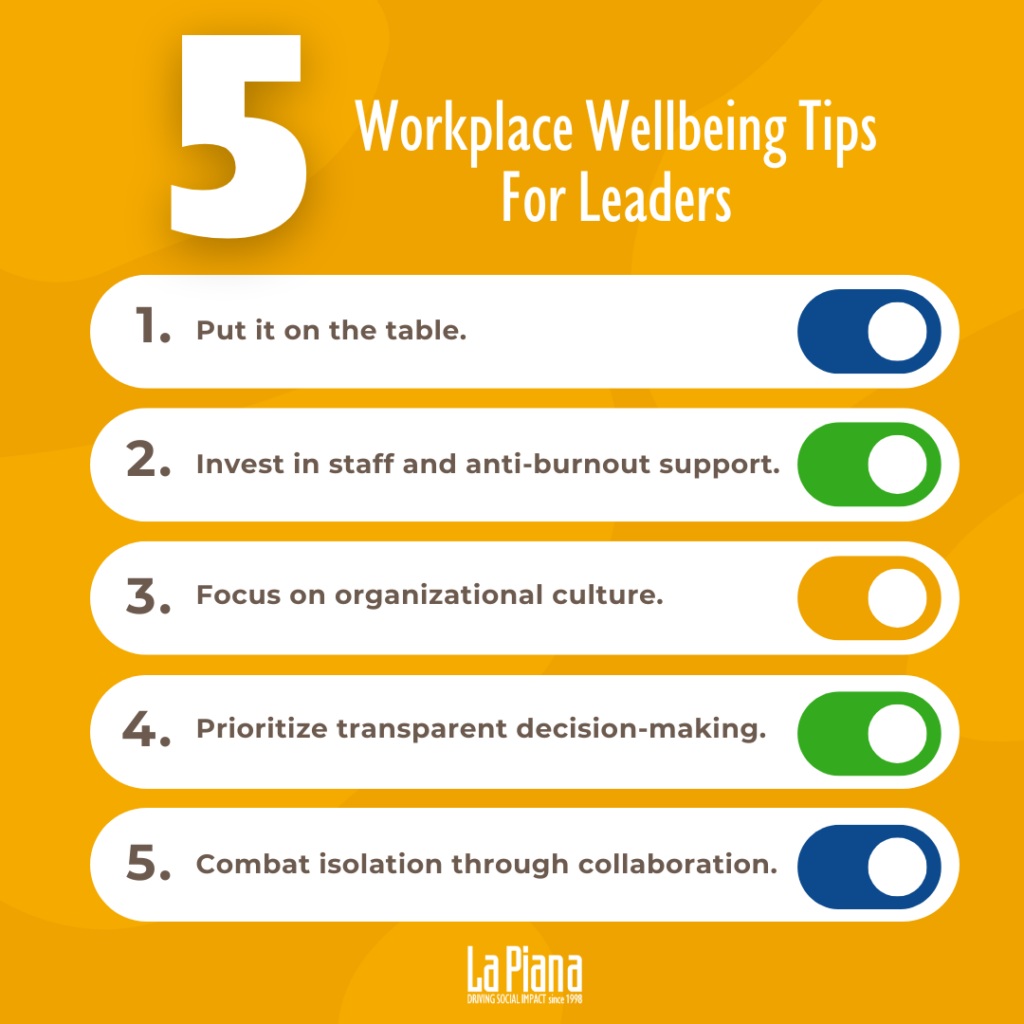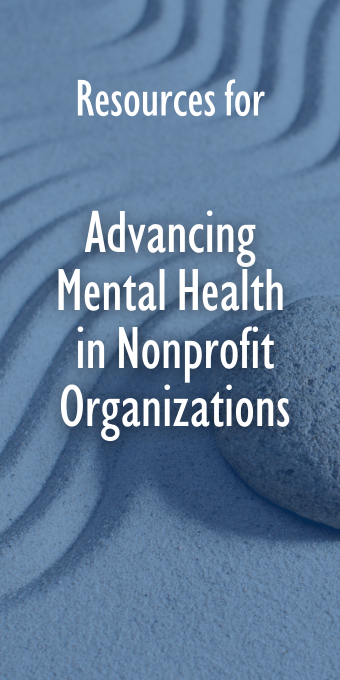Resources for Advancing Mental Health in Nonprofit Organizations
The national dialogue around mental health, which surged during the COVID-19 pandemic, remains crucial today, particularly in the context of the workplace. Nonprofit organizations in particular face a unique set of challenges when it comes to employee wellbeing.
- Heightened pressure of decision-making. Nonprofits face acute workplace related stressors. Whether you’re in a direct service organization or working at the systems-level, the beneficiaries of your mission are the communities you serve. The impact of a nonprofit’s decisions has direct implications and consequences on those communities and individuals served. This often adds weight and increases stress related to even minor decisions. Will your staffing changes mean a child won’t get the educational support they need to thrive? If you de-prioritize a policy initiative to focus on another, does that mean a family won’t be able to put food on the table? These decisions, small and large, weigh on nonprofit staff daily.
- Compassion fatigue (aka secondary traumatic stress). We often talk about compassion fatigue in the context of direct service organizations, but secondary traumatic stress also applies to those engaging in systems-change efforts. As advocates for our mission, it can be difficult to face the realities communities are experiencing every day. Whether you’re working on persuasive materials for policy makers or developing recommendations for change, change agents across the sector are both motivated by and fatigued by the stressors we face.
- Resource constraints and diminished collaboration. The reality of working for a nonprofit is that we often have to make-do with limited resources. Despite efforts advocate for more unrestricted funding sources and increased resourcing for the sector writ large, the reality is that nonprofits continue to face constraints. These constraints can directly impact organizational infrastructure investments such as HR, as well as stifle innovation and collaboration as staff conserve and prioritize resources externally.
- Constant change. Many nonprofits experience frequent ebbs and flows that take a toll on staff and leaders alike. Funding sources, private or public, can change without warning, adding pressure to fundraisers and lurching programmatic work; policy changes can impact the ability of nonprofits to advance mission critical work; and evolving community needs can change organizational strategies all together. These twists and turns take a toll on wellbeing and mental health and in a presidential election year, changes on the horizon can cause added uncertainty about the future.

What Can We Do?
Fortunately, many resources for nonprofits already exist, and some have even become more readily available thanks to shifts in national workplace conversations. Below are some tips for addressing workplace wellbeing for nonprofit organizations.
For Leaders
- Put it on the table. As noted above, nonprofit employees face unique stressors at work. It’s important to acknowledge these challenges. According to the 2024 NAMI Workplace Mental Health Poll, when employees are less comfortable talking about their mental health at work, they are more likely to report feeling burnout.[1] We can’t begin solving a problem that hasn’t been named, so a logical first step is to embrace discussions of mental health. At your next meeting, add an agenda item or thoughtful ice breaker to open the conversation, hold a town hall or listening session on how staff are feeling, and, most importantly, be vulnerable yourself and model dialogue with colleagues.
- Invest in staff and anti-burnout support. Burnout is a problem across the job market, but rates are especially high among women, young workers, and mid-level employees.[2] Burnout poses a risk to organizations by negatively impacting quality of work and contributions to mission success. It can lead to turnover, which can burden organizations with additional costs, time investments in hiring and training new staff, as well as losing institutional history. In 2022, La Piana conducted a survey to learn more about how organizations can combat burnout. Read our top seven tips with practical advice for combatting burnout here.
- Focus on organizational culture. Organizational culture isn’t just the icing on the cake of a good workplace, it can be an effective tool for mitigating stress, burnout, and navigating conflict. There are many elements that contribute to a positive culture, and it can be overwhelming for leaders to identify where to start. One approach, and often the recommendation of our consulting team, is to gather information from staff through an assessment and build a culture workplan based on concrete findings. Learn more about La Piana’s approach to culture assessments here.
- Prioritize transparent decision-making. With the heightened pressure and implications related to decision-making, transparency in how decisions are made, who has the final decision, and what factors are considered, can ease staff stress. Clarity on processes and roles in decision-making help staff set expectations and feel respected. Further, staff who understand the factors that were considered in reaching a choice can more easily get behind the outcomes. Providing clear, consistent criteria staff can use for making decisions in their own work goes a step further in providing a framework that can ease staff stress and empower individuals in their roles.
- Combat isolation through collaboration. Many organizations who we work with name working in silos as a key barrier to work, but this type of isolation can also have an impact on feelings of loneliness and overall mental health. A key way organizations can support wellbeing is by fostering collaboration. Internally, building relationships with coworkers is just as important as setting up infrastructures to support collaborative efforts. Whether it’s spending a few minutes of a meeting to check-in on each other or providing technology platforms for regular communication, peer connections are important.Externally, partnerships and cooperation with other organizations can ease burdens on a single organization while also strengthening mission impact. Consider joining a network or association of like-minded organizations to find potential partners and make concerted efforts to engage peer organizations in ways that enhance your impact.
Supporting mental health for employees isn’t just a noble cause for “do-gooders,” it’s one that can impact the bottom line, mission success, and shaping the future for ourselves and our communities. How are you supporting your nonprofit? Let us know in the comments!
[1] https://www.nami.org/support-education/publications-reports/survey-reports/the-2024-nami-workplace-mental-health-poll/
[2] https://www.nami.org/support-education/publications-reports/survey-reports/the-2024-nami-workplace-mental-health-poll/


Comment section